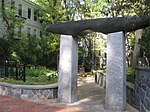The Plough and Stars
1969 establishments in MassachusettsBuildings and structures in Cambridge, MassachusettsDrinking establishments in MassachusettsMusic venues completed in 1969Pub stubs ... and 2 more
Restaurants in Cambridge, MassachusettsTourist attractions in Cambridge, Massachusetts

The Plough and Stars is a bar and music venue in Cambridge, Massachusetts. It was founded in 1969 by brothers Peter and Padraig O'Malley, named after the play by Seán O'Casey. The Boston Globe and Boston Phoenix have noted its disproportionate cultural influence for its size, with a number of noted musicians, writers, and politicians frequenting the bar over the years.
Excerpt from the Wikipedia article The Plough and Stars (License: CC BY-SA 3.0, Authors, Images).The Plough and Stars
Massachusetts Avenue, Cambridge Cambridgeport
Geographical coordinates (GPS) Address Nearby Places Show on map
Geographical coordinates (GPS)
| Latitude | Longitude |
|---|---|
| N 42.368305555556 ° | E -71.108722222222 ° |
Address
Massachusetts Avenue 902;904;906;908;910;912
02139 Cambridge, Cambridgeport
Massachusetts, United States
Open on Google Maps










